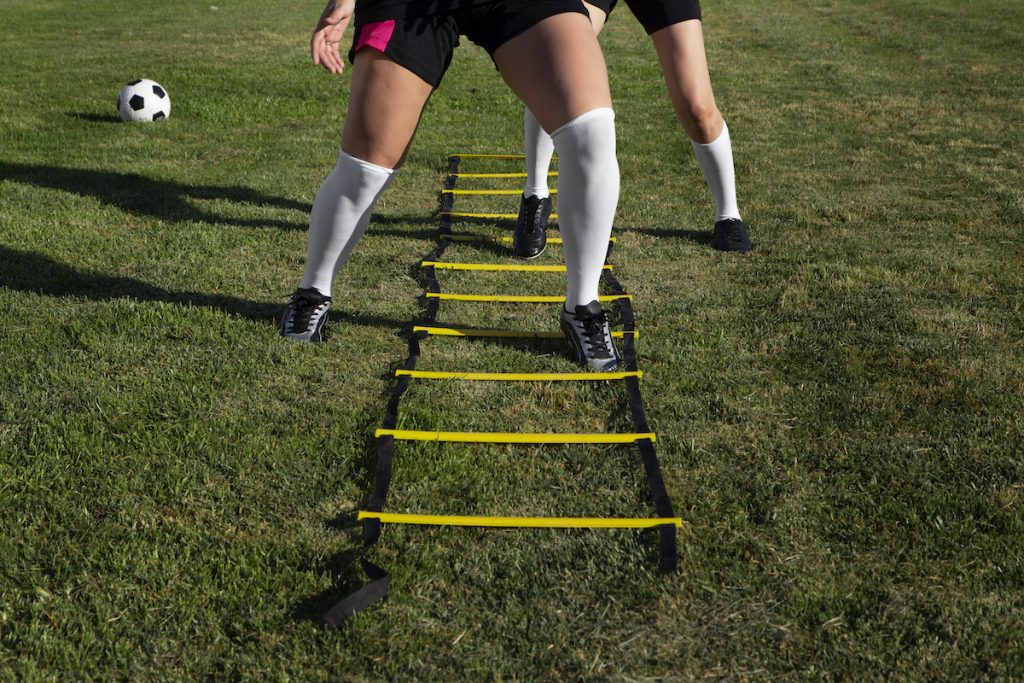With fall sports quickly approaching, it’s time to get our heads (and bodies ready) for the game. Fall training means a focus on specific sports drills and techniques to increase skill set to prepare for intense competition on the field, court, or track. Whether you’re playing football, soccer, cross country, or volleyball, agility and speed are critical components of your athletic performance. These skills not only help you move faster but also enhance your ability to change direction quickly and efficiently. To give yourself an edge this season, it’s crucial to incorporate specific drills into your training routine that target agility and speed.
Here are some speed and agility drills to help athletes prepare for fall sports.
Why Speed and Agility Matter In Fall Sports
Speed in its simplest definition is the ability to move rapidly in a straight line. Athletes need speed, not just if they run cross country, but also for sports that require skills like football, soccer, and lacrosse.
Agility is the ability to move quickly and change direction with ease while maintaining control of your body. It’s the difference between beating your opponent to the ball in soccer or dodging a tackle in football.
Together, these skills set athletes apart from the competition. Speed and agility allow athletes to execute plays with precision and respond effectively when it comes to both offense and defense to the fast-paced nature of most fall sports.
Top 3 Speed Drills For Fall Sports Training
Sport training should include speed drills to prepare for the fall season. Speed drills fire up those fast twitch muscle fibers needed to run fast at the drop go a hat. The following are 3 speed drills to add to programming:
Sprints: Speed drills often begin with simple sprints. Performing short, intense sprints of 10, 20, or 40 yards helps improve your explosive power and acceleration. Incorporate different starting positions, like a standing start, three-point stance, or backpedal to sprint, to simulate game conditions.
Hill Sprints: Hill sprints are excellent for building leg strength and power, which are essential for speed. Find a hill with a moderate incline and sprint up as fast as you can. Walk back down to recover and repeat. Hill sprints are particularly beneficial for cross country runners and football players, as they simulate the resistance and challenge of moving against gravity.
Resisted Runs: Using resistance bands or a sled can add a level of difficulty to your sprinting drills. The added resistance forces you to exert more power, which translates to increased speed when the resistance is removed. This type of training is especially useful for sports that require quick bursts of speed, like soccer and track events.
Top 3 Agility Drills For Fall Training
Sports like football, lacrosse, soccer, and rugby all require agility. Think of every time athletes need to in an instant stop and switch directions. It’s important to work on agility drills so that the body can properly maneuver these moves safely without injury.
Here are some agility drills:
Ladder Drills: Ladder drills are a staple in agility training. These exercises involve a series of quick steps through a rope ladder laid on the ground. The drills help improve foot speed, coordination, and balance. Some popular ladder drills include the two-foot in-out, lateral shuffle, and the Ickey shuffle. By practicing these regularly, you’ll develop faster footwork, which is essential for sports like soccer and basketball.
Cone Drills: Cone drills are versatile and can be adapted to simulate the movements required in different sports. The “T-Drill” is particularly effective for building lateral speed and agility. Set up four cones in a T-shape and sprint to each cone, focusing on sharp, controlled movements. The “W-Drill” is another excellent exercise, where you sprint diagonally from cone to cone, mimicking the quick directional changes seen in sports like football and lacrosse.
Box Drills: Box drills enhance your ability to change direction rapidly. Place four cones in a square, about five yards apart. Start at one corner, sprint forward to the next cone, shuffle sideways, backpedal, and then shuffle back to the start. This drill is particularly useful for sports like volleyball, where quick directional changes are crucial.
Putting Speed And Agility Together
To maximize the benefits of these drills, consistency is key. Incorporate agility and speed drills into your training routine at least three times a week. Start each session with a dynamic warm-up to prepare your muscles and joints for the intense workout ahead. After completing the drills, finish with a cool-down that includes stretching to maintain flexibility and reduce the risk of injury.

